
The latest achievements of Peking University's Wang Xingjun and Changlin teams have been selected as the "2022 China Photonics Top 10 Progress"
Time:2023-05-10Number of views:3047
On the evening of April 20th, China Laser Magazine released the "2022 Top Ten Developments in China's Optics". The research achievement of the team led by Wang Xingjun and Chang Lin from Peking University, "A Novel Silicon Based Optoelectronic Chip Integrated System Driven by Microcavity Combs," is included in this project, with microsource photons participating as collaborative units.
The following are the selected projects for 2022:
Basic research
(10 items)
1. A Novel Silicon Based Optoelectronic Chip Integrated System Driven by Microcavity Combs
The Wang Xingjun team from Peking University, in collaboration with the John E. Bowers team from the University of California, Santa Barbara, has addressed challenges such as simple and robust excitation and long-term stability of microcavity optical combs, design of silicon based systems for comb light sources, and reconfigurable multi-dimensional spectral shaping technology on silicon substrates. The team has achieved the first international implementation of a new type of silicon based optoelectronic system driven by Kerr microcavity optical combs, which is expected to be directly applied in data centers, 5/6G signal processing The fields of autonomous driving and optical computing provide a new research paradigm and development direction for the next generation of on chip optical electronic information systems.
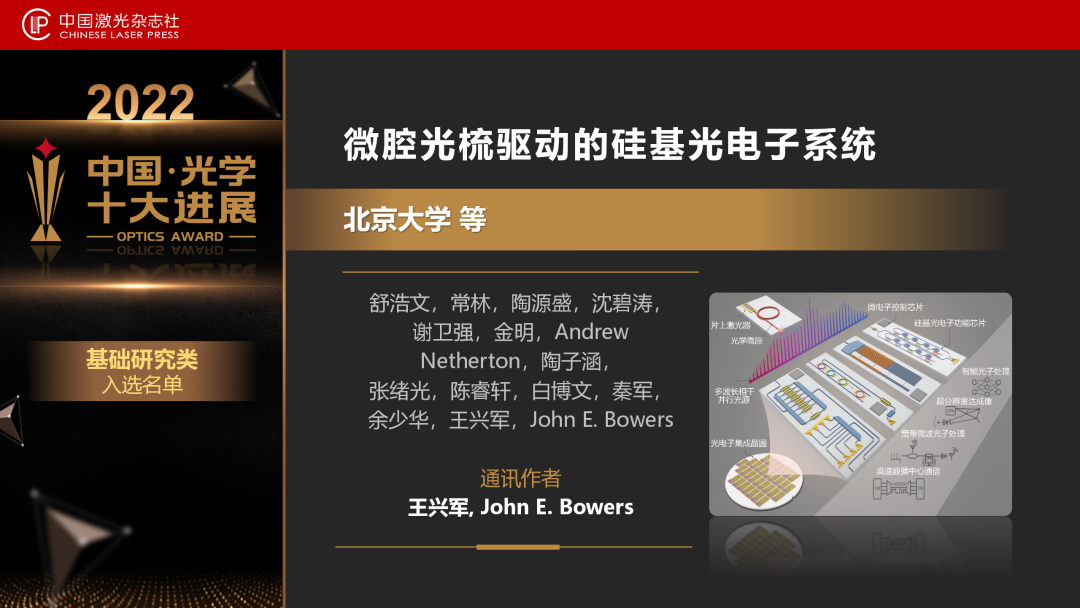
2. The Birth of Optical Vortex Rings
The nanophotonics team led by Zhan Qiwen from Shanghai University of Technology, based on Maxwell's equations and optical conformal transformation, has for the first time fully derived theoretically and experimentally achieved a beautiful optical vortex ring structure. This research work provides a new approach to the generation and characterization of three-dimensional complex spatiotemporal light fields. It will have important and far-reaching significance for theoretical research on circular symmetric electrodynamics, circular symmetric plasma physics, optical symmetry and topology, quantum physics, astrophysics, as well as application research on optical sensing, optical manipulation, optical information and energy transfer.
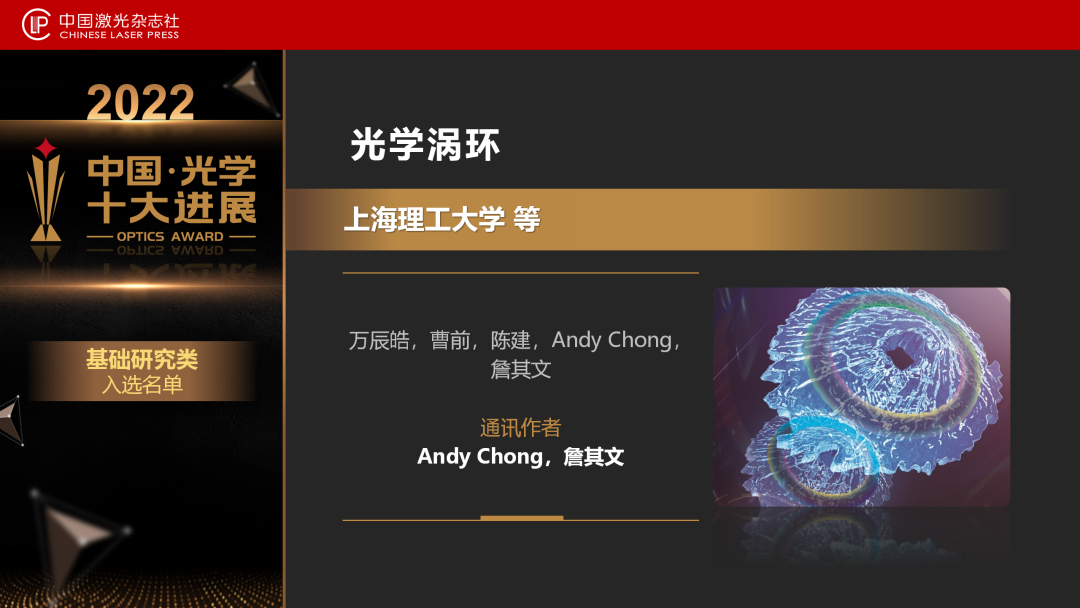
3. 3D printing of nanocrystals using light
The research group led by Sun Hongbo and Lin Linhan from the Department of Precision Instruments at Tsinghua University proposed for the first time the use of photogenerated high-energy carriers to regulate the surface chemical activity of nanomaterials and achieve chemical bonding, thereby achieving three-dimensional laser assembly of functional nanoparticles such as semiconductor quantum dots. This technology has the advantages of true 3D, high purity, high resolution, and heterogeneous integration, opening up a new path for the preparation of functional nano devices. It has broad application prospects in fields such as on chip optoelectronic device integration and high-performance near-eye displays.
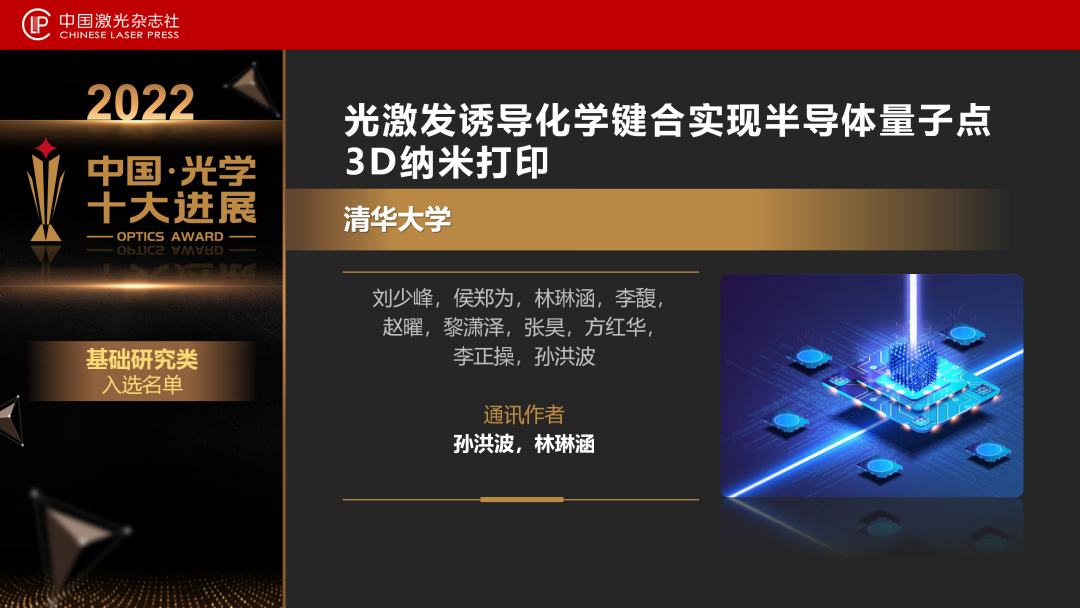
4. New technology achieves laser 3D printing of nanoferroelectric domains for the first time
The research team led by Zhang Yong from Nanjing University has developed a non reciprocal laser polarized ferroelectric domain technology: femtosecond pulse laser is focused on lithium niobate crystal, forming an effective electric field inside the crystal, achieving controllable preparation of three-dimensional nano ferroelectric domains. The processing accuracy has reached 30 nanometers, far exceeding the diffraction limit, and can achieve the correction and reconstruction of ferroelectric domain structures. This technology solves the problem of traditional polarization techniques limited to processing ferroelectric domain structures with micrometer accuracy in two-dimensional planes, and provides new technical support for the development of three-dimensional integrated optoelectronic devices.
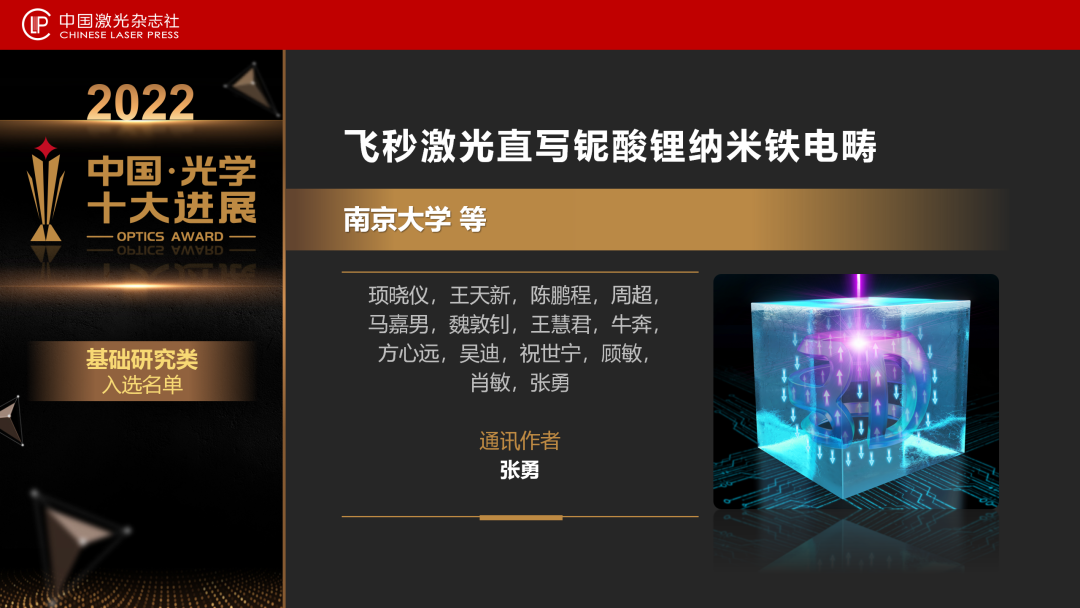
5. Significant research progress has been made in the field of high-purity ultra integrated chiral light sources
The Song Qinghai team from Harbin Institute of Technology (Shenzhen) has achieved high purity, high Q value, and high directionality of chiral fluorescence to laser emission based on the physical properties of bound states in continuous domains. Without the need for spin injection, it is possible to control the spectra, far-field, and spin angular momentum of spontaneous emission and laser. This method is of great significance for improving the design of current chiral light sources and promoting their applications in photonic and quantum systems.
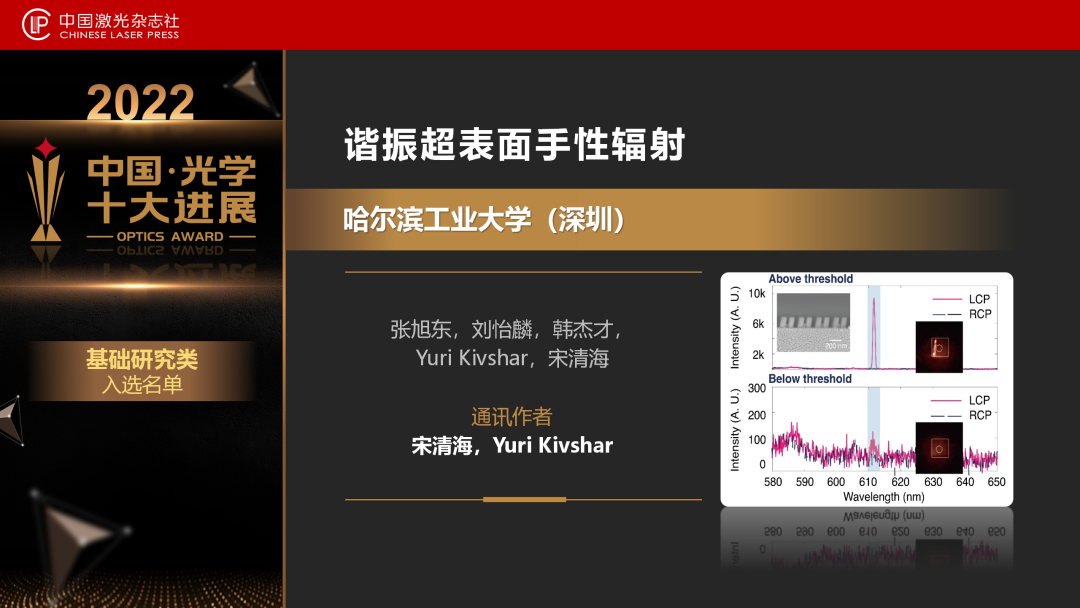
6. The first round of Xihe laser experiment obtained a 60 MeV proton beam
Relying on the State Key Laboratory of Intense Field Laser Physics, Shanghai Institute of Optics and Precision Mechanics, Chinese Academy of Sciences, the Laser Proton Acceleration Research Group used the SULF-10 PW laser to bombard the micron metal target in the first run in experiment. Under the normal sheath acceleration mechanism behind the target, the proton beam with a cutoff energy of 62.5 MeV was obtained, which reached the leading level in China and entered the international forefront. In the future, further optimization will be carried out to obtain 100 MeV level high-energy proton beams, effectively promoting the application of laser proton sources in important fields such as fusion energy and tumor therapy.
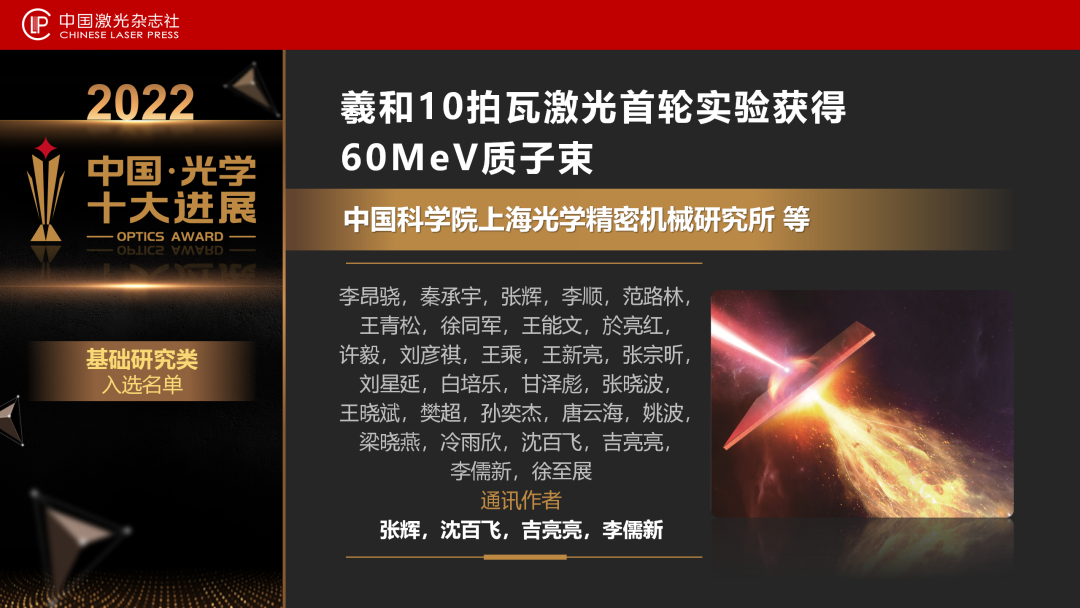
7. Efficient, high repetition rate ultra fast coherent ultraviolet light source
The research group of Liu Feng, Chen Min, and Li Boyuan from Shanghai Jiao Tong University successfully achieved active regulation of micrometer scale pre plasma by introducing circularly polarized pre pulses, constructing a suitable longitudinal density distribution, and solving the problem of high order harmonic generation limited by laser contrast. The experiment verified a new scheme for generating high repetition frequency and high brightness ultra-fast ultraviolet radiation sources.
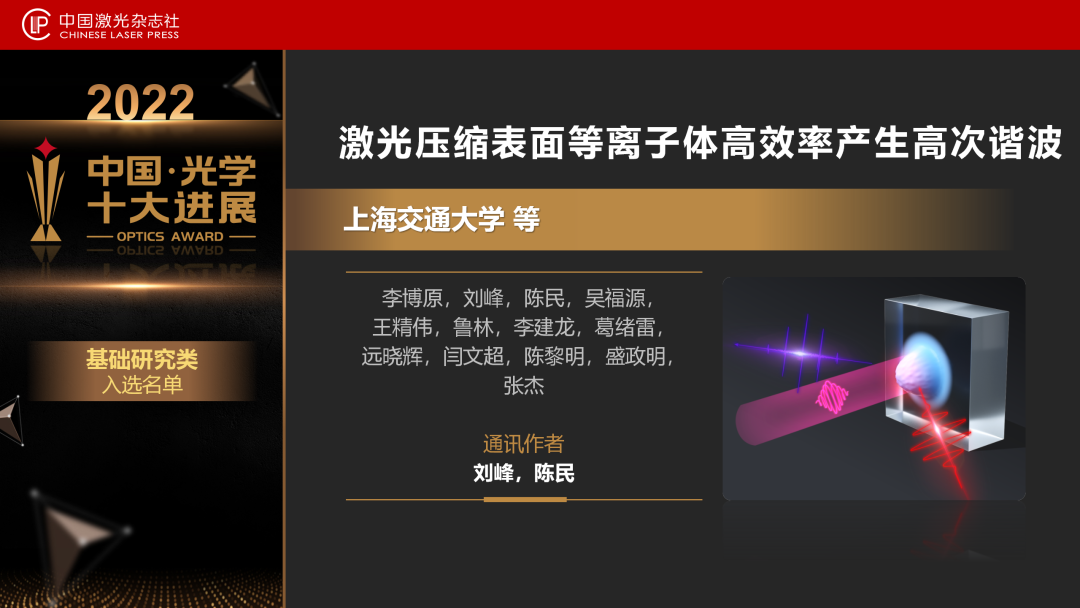
8. The f-f transition luminescence lifetime of rare earth ions is compressed to nanosecond level
The teams of Zhang Zhenglong and Zheng Hairong from the School of Physics and Information Technology of Shaanxi Normal University have made breakthrough progress in the field of nanooptics, relying on their self-developed high-resolution in-situ spectroscopy system. By using plasmon tilted nanocavities, the luminescence lifetime of rare earth ions during f-f transitions is compressed to below 50 nanoseconds, while achieving quantum yield enhancement of over 1000 times. This achievement was evaluated by the reviewers as a "milestone" work in the field of rare earth luminescence, which is of great significance for expanding the advantages of rare earth luminescence applications and promoting the development of quantum communication single photon sources and nano lasers.
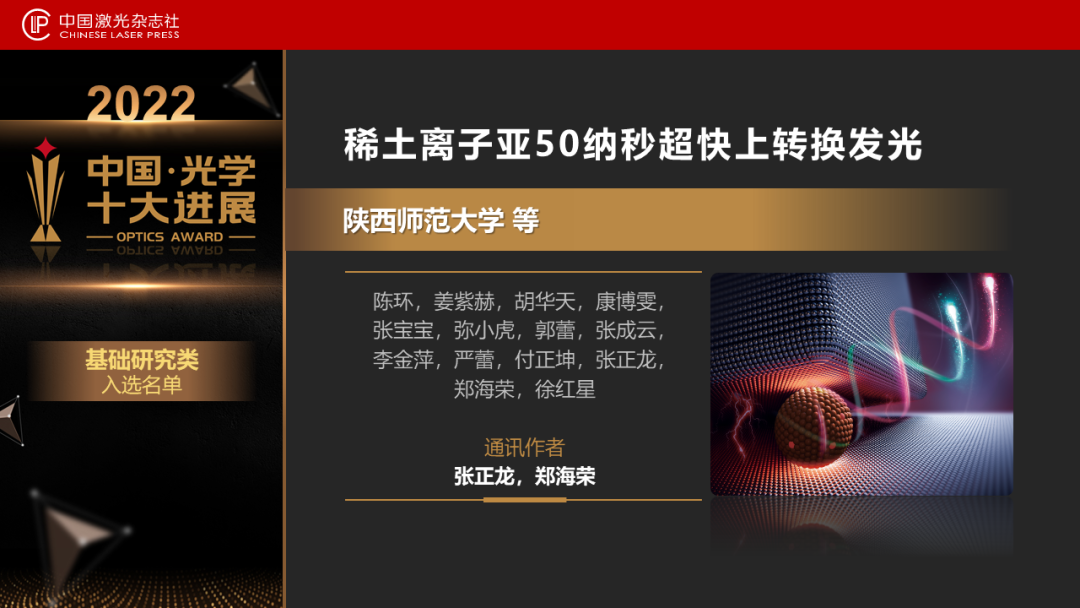
9. Quantum Transcendence of Laser Interferometers
The Zhang Weiping team and collaborators from the School of Physics and Astronomy at Shanghai Jiao Tong University and the Li Zhengdao Research Institute have cleverly combined their developed quantum correlation interferometry technology with laser interferometers to achieve a new type of quantum precision measurement technology that surpasses traditional laser interferometers. The new method integrates classic quantum advantages and can theoretically be extended to large precision measurement instruments such as LIGO gravitational wave detectors, achieving an upgrade of traditional interference technology and taking an important step towards exploring truly valuable quantum technology.

10. Laser radiation that breaks through the fluorescence range
The teams of Yu Haohai and Zhang Huaijin from Shandong University, as well as Chen Yanfeng from Nanjing University, have collaborated on research and achieved breakthroughs in the field of laser physics. For the first time, laser radiation based on multi phonon coupling has been achieved, achieving wide band and tunable laser output in the far superfluorescence spectrum range. The research results have broadened the range of laser gain, elucidated the key functional elements and order relationships in laser crystals, and are of great significance for the development of solid-state laser technology.
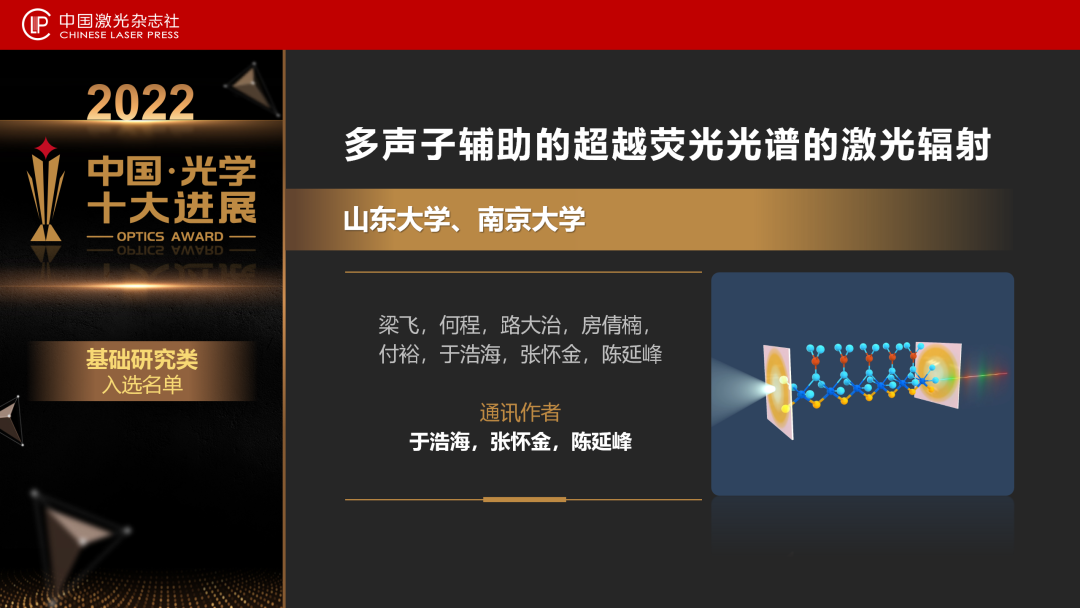
Applied Research
(10 items)
1. Integrated imaging chip for aberration correction in 3D photography
The teams of Fang Lu and Dai Qionghai from the Imaging and Intelligent Technology Laboratory of Tsinghua University have proposed a new architecture of digital adaptive optics under incoherent light, which decouples signal acquisition and aberration correction, achieving high-speed and large-scale block aberration removal for the first time. We have developed an integrated metaimaging chip that can achieve large field of view, high-resolution, and high-speed 3D imaging for aberration correction. This has increased the effective field of view diameter of traditional adaptive optics from 40 to 1000 seconds, and can be widely used in fields such as astronomical observation, industrial detection, and medical diagnosis.
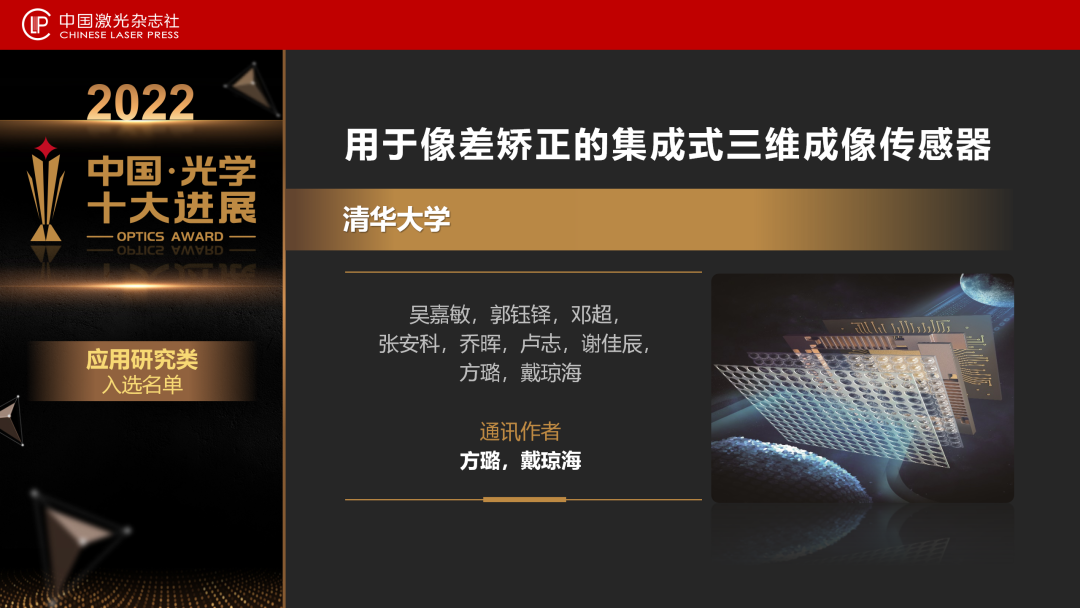
2. Fine manipulation of semiconductor nanocrystal band structures in the spatiotemporal domain
The team led by Qiu Jianrong from Zhejiang University and Tan Dezhi from Zhijiang Laboratory collaborated to reveal a new law of femtosecond laser induced spatially selective mesoscale phase separation and ion exchange, achieving fine regulation of element distribution in glass micro regions, exploring new technologies for femtosecond laser 3D extreme manufacturing, and constructing a 3D luminescent broadband continuously tunable nanocrystalline structure, This three-dimensional micro nano structure is proposed and demonstrated for the first time in cutting-edge applications such as ultra large capacity and ultra long lifespan information storage, highly stable Micro LED arrays, and dynamic stereoscopic color holographic displays.

3. Planar wide-angle camera based on integration of metalenses
The team led by Li Tao from Nanjing University has developed a planar wide-angle camera based on a super structured lens array, which can achieve high-quality wide-angle imaging with a viewing angle of over 120 ° using only a micrometer thick nanostructure. The design principle of this new principle has successfully broken through the limitations of traditional commercial fisheye lenses in terms of volume and weight, demonstrating the enormous application potential of metalens design in disruptive imaging technology.
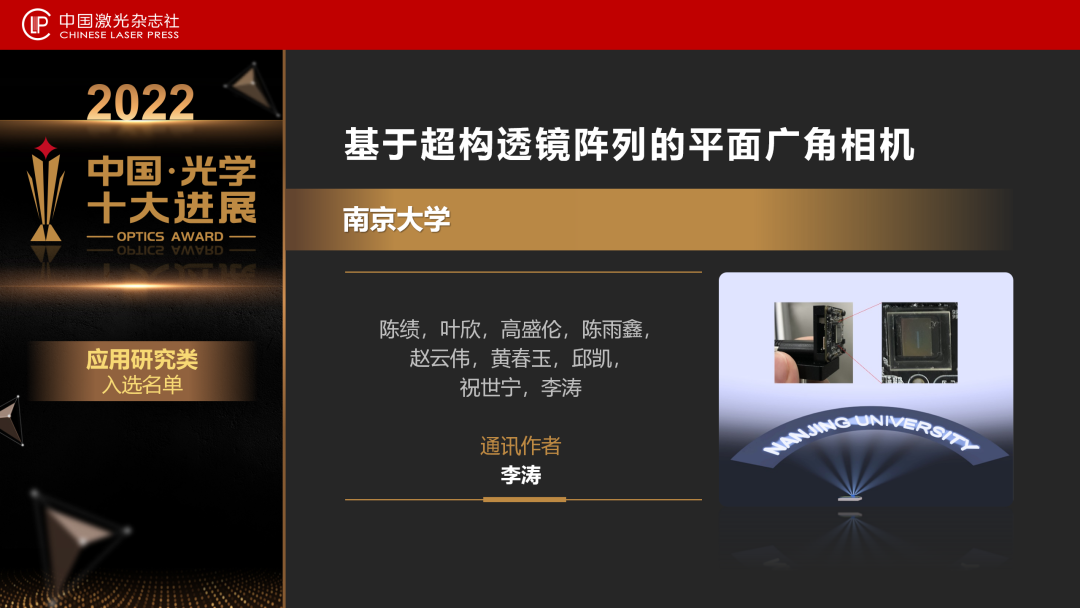
4. Optoelectronic integrated light and micro "compound eye camera" to solve the problem of incompatibility with commercial detectors
The collaborative team led by Zhang Yonglai from Jilin University used femtosecond laser microfabrication technology to manufacture three-dimensional biomimetic compound eyes with logarithmic contour small eyes, breaking through the problem of non planar imaging of three-dimensional compound eyes and mismatch of commercial micro CCD/CMOS detectors. They developed a photoelectric integrated micro compound eye camera with a mass of only 230 mg, and achieved three-dimensional reconstruction of micro target motion trajectories using the principle of multi eye vision and neural network reconstruction algorithms. This achievement is of great significance in cutting-edge fields such as medical endoscopic imaging and micro robot vision.

5. New Record of Fiber Optic Quantum Key Distribution - No Relay Secure Transmission Over 830 kilometers
The teams of Guo Guangcan and Han Zhengfu from the University of Science and Technology of China have solved the problems of extremely weak light dual field preparation and low noise fast phase compensation, broken through the signal-to-noise ratio limit, and created a world record for 830 kilometers of relay free optical fiber quantum communication. Compared to the work of other teams at home and abroad, this achievement not only increased the distance of relay free transmission by over 200 kilometers, but also increased the coding rate by 50-1000 times, taking an important step towards achieving ground-based quantum communication over a thousand kilometers.
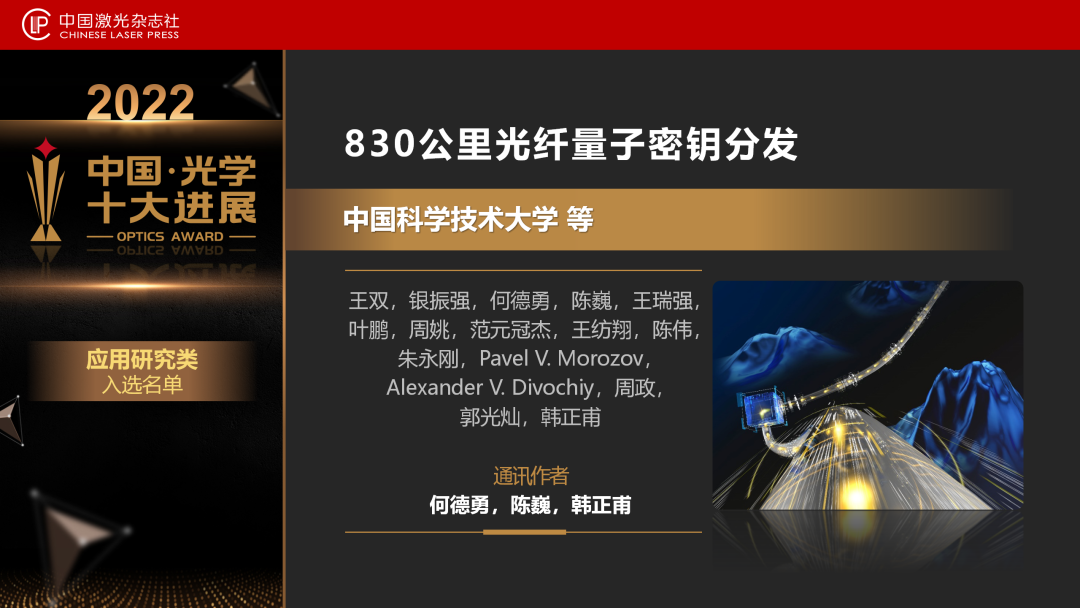
6. Optical frequency perfect abnormal reflector
Wang Zhanshan and Cheng Xinbin from the School of Physical Science and Engineering at Tongji University, in collaboration with Zhou Lei from the Department of Physics at Fudan University, proposed a quasi three-dimensional subwavelength new structure consisting of a one-dimensional multilayer film combined with a two-dimensional metasurface. Through efficient coupling of transmitted waves and Bloch waves, the ability to regulate non local energy flow is enhanced, and for the first time, an optical frequency anomalous reflection with an efficiency better than 99% is achieved. The research results are expected to promote the development of new beam scanning systems and other instruments and equipment.
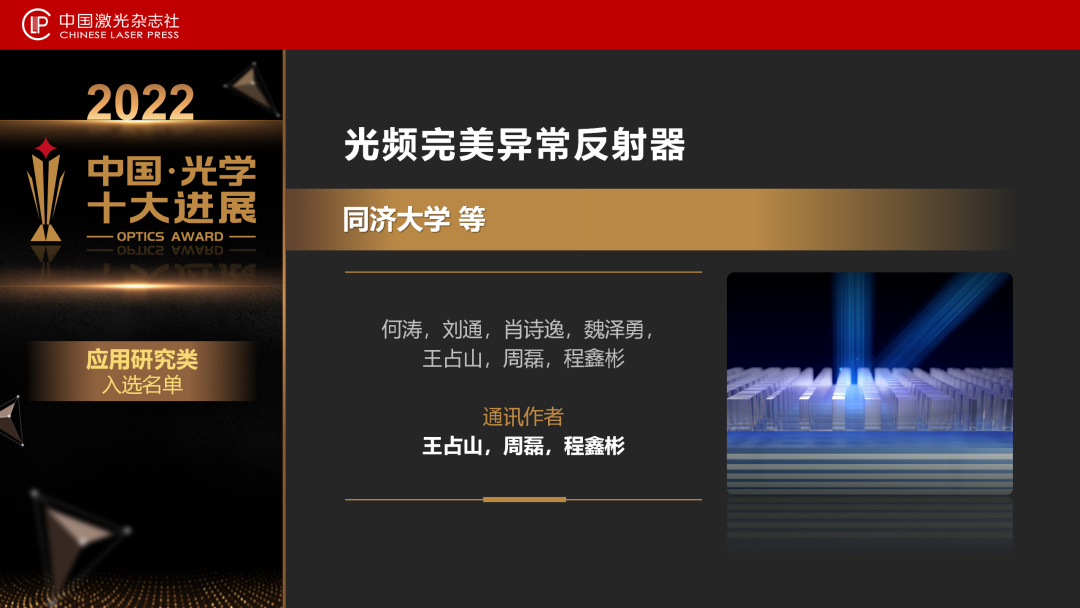
7. Long life perovskite LED
The team led by Di David and Zhao Baodan from Zhejiang University utilized bipolar molecular stabilizers to suppress ion migration, achieving for the first time an ultra long lifespan perovskite LED that meets practical application standards. At a light power equivalent to high brightness OLEDs, these near-infrared LEDs have a lifespan of 32675 hours (3.7 years); At lower irradiance, its lifespan is expected to reach up to 270 years. These record breaking devices operate at 5 mA/cm ² Under constant current for 5 months, there was no significant decrease in radiance.
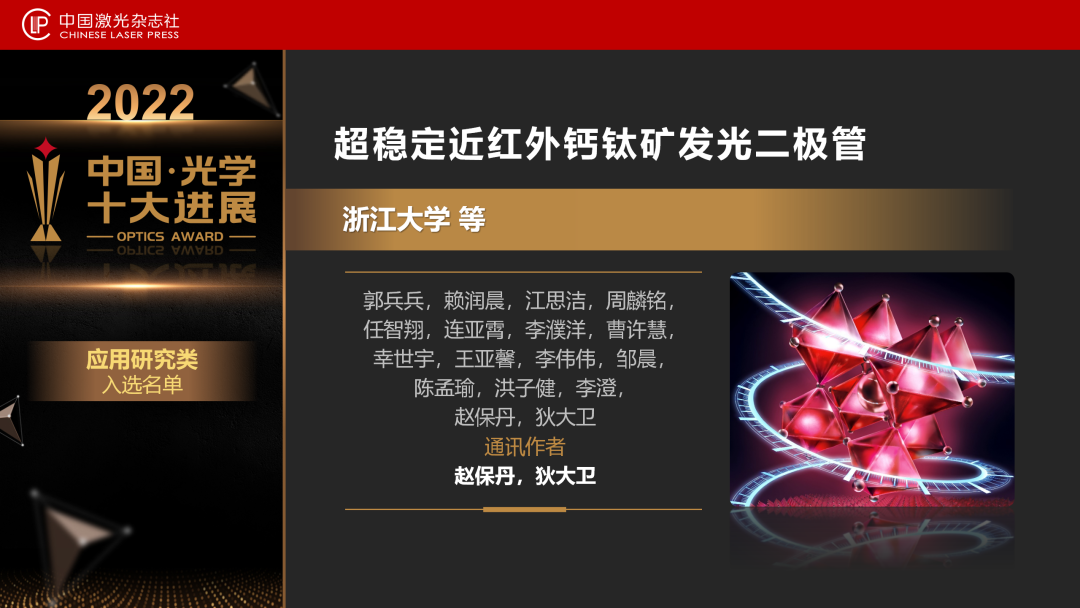
8. The world's first lithium niobate thin film polarization multiplexing coherent light modulator
The Cai Xinlun research group at Sun Yat sen University has achieved the world's first lithium niobate thin film polarization multiplexing coherent light modulator, which has a CMOS compatible half wave voltage and a modulation bandwidth of 110 GHz. This is currently the world's highest performance ultra-low voltage and ultra wide bandwidth electro-optical modulator chip. Using this chip, the research team demonstrated the current highest net rate of single carrier coherent transmission -1.96 Tb/s. This study has conquered the indispensable electro-optical converter components in the next generation of ultra high speed and low-power coherent optical transmission systems. The research on lithium niobate thin film materials and their photonic integration technology provides a strong guarantee for achieving independent and controllable control of China's optical communication industry chain.
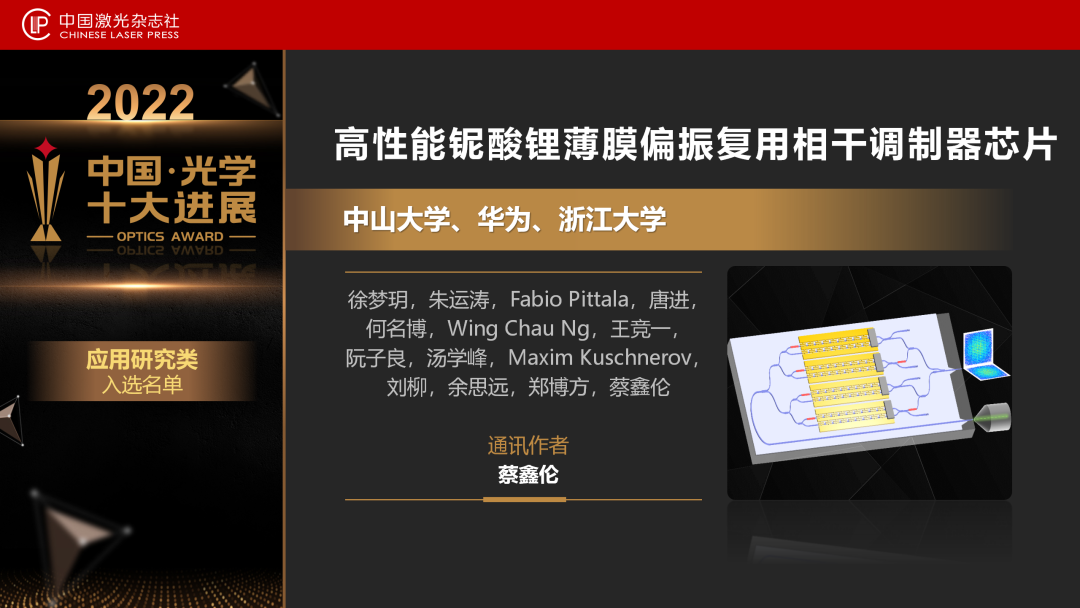
9. First discovery of interface echo wall modes in optical microcavities
Xiao Yunfeng's team from the School of Physics at Peking University collaborated with Chen Youling from the Institute of Semiconductors of the Chinese Academy of Sciences to discover for the first time the interface echo wall mode in optical microcavities. Researchers have adjusted the electromagnetic field peak of the optical echo wall mode to the sensing surface in the integrated microbubble cavity of microfluidic technology, which has physically improved the optical response intensity of the sensor and successfully achieved a microfluidic sensor device with single molecule response. This has broad application prospects in the field of high sensitivity micro detection.
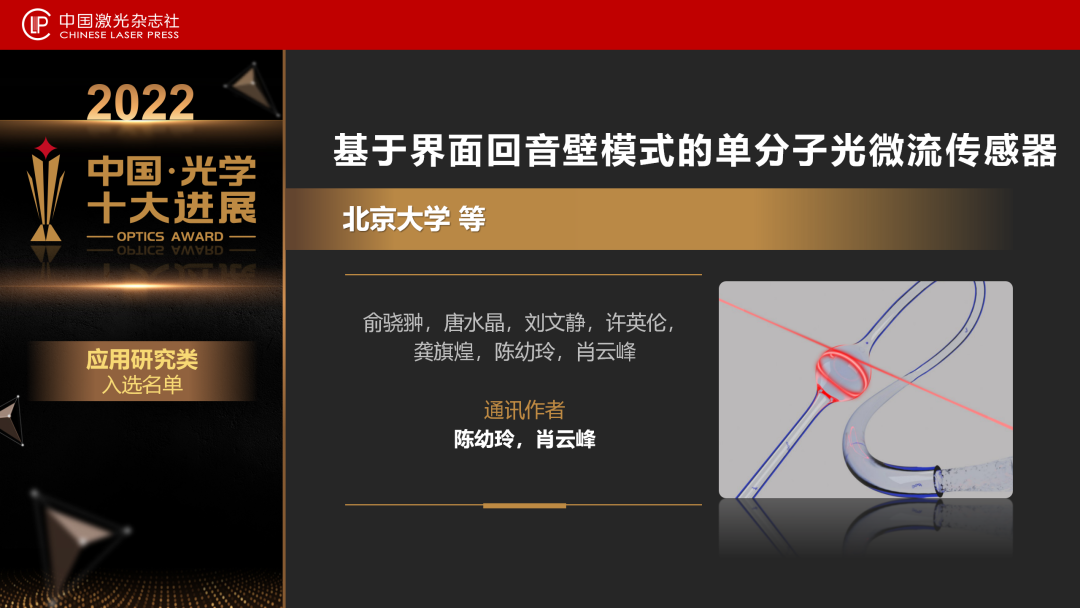
10. Breakthrough research progress in the application of optical encoded liquid crystal metastructures
Collaborating with Zhu Weihong, Zheng Zhigang, and Feringa from the School of Chemistry and Molecular Engineering, School of Physics, and the Joint Research Center of Feilinga Nobel Prize Scientists at East China University of Science and Technology, we aim to address the issue of low optical efficiency in traditional liquid crystal systems through material design, preparation, and external field control of microstructures, enabling the development of reversible, erasable, and gradient liquid crystal microstructures with a wide dynamic range of optical control The multiple anti-counterfeiting new technologies of structural superposition and embedding provide a technical solution for solving the material bottleneck faced by China in the field of high-end anti-counterfeiting technology, which can be used for reference.
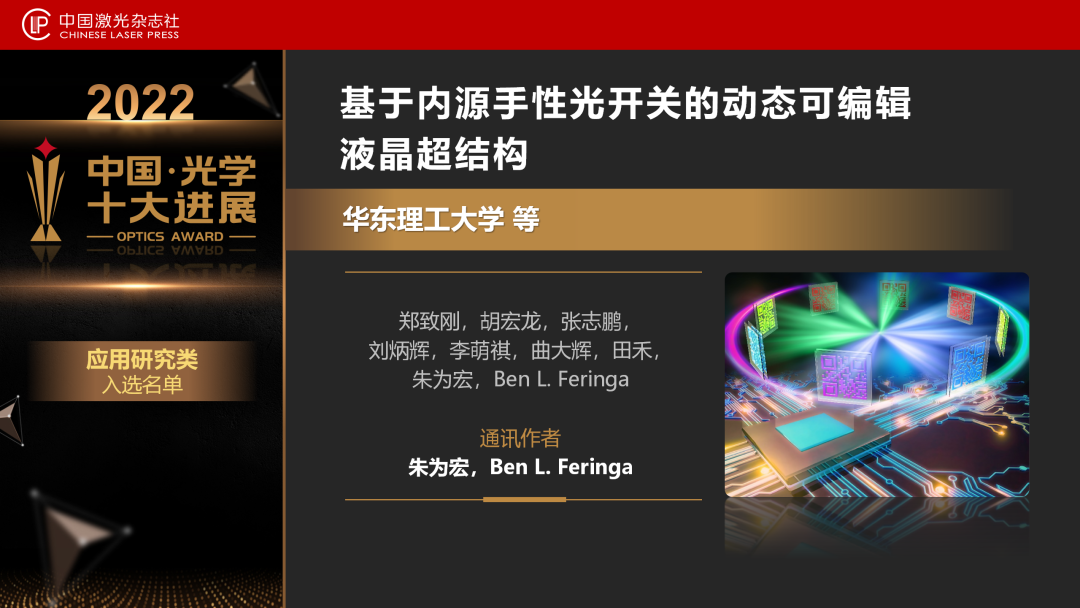
The "Top Ten Advances in Chinese Optics" selection activity was initiated by China Laser Magazine and has been successfully held for 17 times. The aim is to promote the widespread dissemination of excellent optical research achievements in China and promote the development of China's optical industry. With high academic level candidate achievements and a strict and fair evaluation mechanism, this award is recognized by the industry and has high credibility and influence.
News source: China Laser Magazine